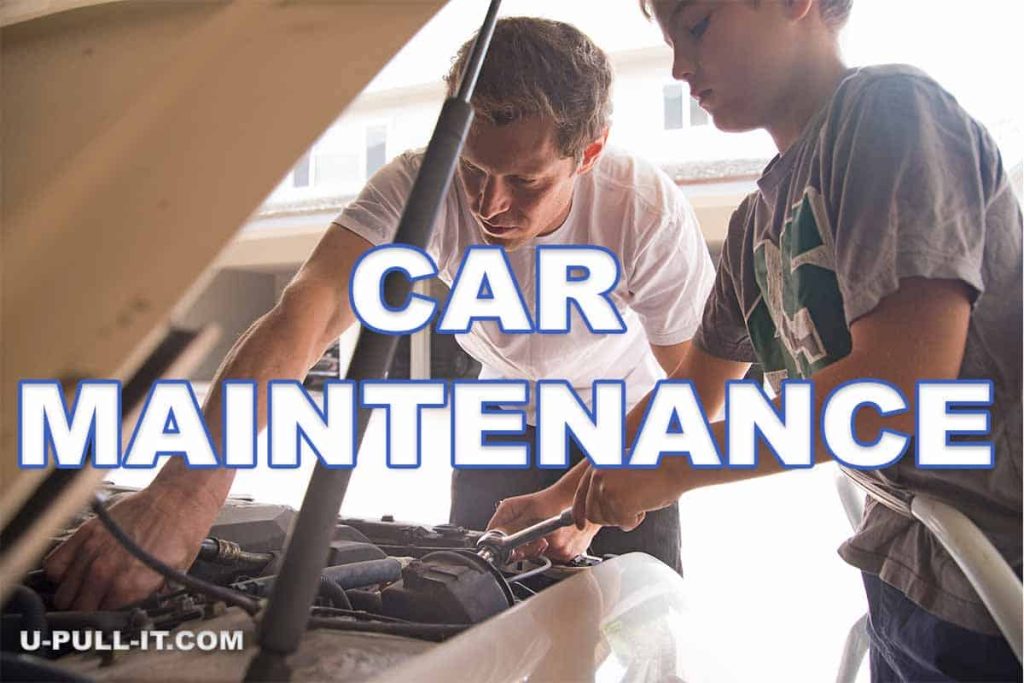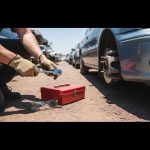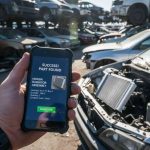Having a car is a great way to get around, but it requires regular maintenance to keep it running smoothly and safely. In this blog post, we will discuss five essential maintenance tips that can help you keep your car running optimally. By following these tips, you will ensure that your car is safe and reliable for years to come. We will look at the benefits of each tip, as well as the recommended intervals for performing each task and how to do them correctly. With this knowledge in hand, you will be able to keep your car running like new!

Essential Car Maintenance Tip #1: Regular Oil Changes.
Regular oil changes are essential for keeping your car running smoothly and efficiently. Changing the oil in your car regularly helps reduce wear and tear on the engine, improve fuel economy, prevent overheating, and maintain the performance of critical components like pistons and valves.
By regularly changing your oil at the manufacturer-recommended intervals (which can range from every 3 months/3,000 miles up to every 12 months/12,000 miles depending on your make and model), you’ll be able to ensure that all of these benefits are maximized.
Recommended Intervals for Oil Changes.
For most makes and models of cars, it is recommended that you change the oil every 3 months or 3,000 miles (whichever comes first). This may vary slightly depending on your vehicle type – consult your vehicle’s owner’s manual or ask a qualified mechanic to find out what is best for your particular make and model.
How to Change Your Oil.
Changing your own oil can be a simple process if you have access to essential tools such as jack stands or ramps (for raising the vehicle off the ground) and a socket set for removing bolts from under the hood. Start by lifting up one side of the vehicle with either jack stands or ramps until it’s level enough for you to get underneath safely; then locate where each component needs to be removed (referring back to any diagrams provided in your vehicle’s owner’s manual) before draining out any old oil into an approved container; replacing filters if necessary; adding new oil; reinstalling parts according to their original positions; topping up levels as needed; finally taking it out for a test drive afterward!

Essential Car Maintenance Tip #2: Regular Tire Rotations.
Regular tire rotations provide several significant benefits for your car’s performance and safety. For starters, rotating your tires helps them wear evenly. This is especially important if you regularly drive on uneven surfaces or roads with sharp turns, as it can help reduce the chances of premature tire wear or blowouts due to excessive strain on one side of the vehicle. Additionally, regular tire rotations can help improve your car’s fuel efficiency by reducing rolling resistance and helping maintain optimal tread depth across all four tires.
Recommended Intervals for Tire Rotations.
For most cars, it is recommended that tires be rotated every 5,000-7,500 miles (8,000-12,000 km) or at least twice a year. However, this interval may vary depending on the type of vehicle and driving conditions you experience regularly; consult your owner’s manual for more specific guidance from the manufacturer regarding how often to rotate your tires based on these factors, also check the tread depth of your tires in case they are worn out.
How to Rotate Your Tires:
Before beginning a tire rotation process for yourself at home or taking it in to a professional mechanic for service, you will want to make sure that all four tires are properly inflated according to the recommendations in your owner’s manual—this is essential for any successful tire rotation procedure! Once this step has been completed successfully, then proceed with the following steps:
1) Jack up each corner of the car and remove one wheel at a time; place each removed wheel aside nearby, so they are accessible during reassembly later on in the process.
2) Begin by swapping out the front left tire with either the back right or back left—whichever location puts less stress on related suspension components like axles and struts when compared against an alternate position swap; then repeat this step with both rear wheels moving into their respective new positions up front (right rear going where left was previously located etc.).
3) Reattach each wheel using lug nuts tightened securely but not overly so (avoid using power tools during reattachment). Finally, once all four wheels have been reinstalled lower jack stands slowly until the car rests firmly on the ground surface again—and that’s it! You should now have successfully completed a basic DIY tire rotation procedure without any major issues encountered along the way!

Essential Car Maintenance Tip #3: Regular Fluid Checks.
Regularly checking your car’s fluids is essential to keeping your car running smoothly and safely. Checking the levels and condition of fluids such as conventional motor oil, coolant, brake fluid, power steering fluid, transmission fluid, and windshield washer solvent can help you identify any potential problems with your vehicle before they become serious issues. Additionally, regularly changing these fluids can help prevent corrosion or wear on components such as brake pads or engine parts.
Recommended Intervals for Fluid Checks.
Generally speaking, you should check the levels and condition of all of your vehicle’s fluids at least once every three months (or every 5,000 miles). However, depending on the age and make/model of your car as well as other factors such as climate or terrain conditions, you may have to adjust this recommended frequency slightly higher or lower than the standard recommendation. For example, if you live in a very hot climate, then it is likely that more frequent checks are necessary due to increased evaporation rates which could cause major damage to important components like brakes or engine parts if left unchecked for too long.
How to Check Fluid Levels.
Checking fluid levels can be done quickly and easily in just a few minutes by following these simple steps:
• Park your car on level ground with the parking brake engaged; this will ensure that all readings are accurate when taking measurements from the dipsticks located in each compartment where a particular type of fluid resides (e.g., engine oil is located inside an engine bay whereas brake fluid is stored inside its own dedicated tank).
• Locate each respective dipstick; most cars will have several different types of dipsticks (i.e., one for oil levels, one for transmission fluid levels, etc.), so take note of which type relates to which compartment before attempting any checks/changes
• Pull each dipstick out slowly, using caution not to spill any liquid during removal; wipe off any residue from previous readings before reinserting back into place with slow, controlled movements until fully seated
• Check the reading against manufacturer recommendations; readjust accordingly by adding additional amounts if necessary, but always be mindful not to overfill compartments at risk of damaging sensitive parts due to pressure build-up
• Replace each dipstick back into place and ensure all readings are double-checked before proceeding with any other maintenance activities
• If any fluid levels appear excessively low or dirty, then it is likely that a more serious issue exists and professional attention should be sought as soon as possible.

Essential Car Maintenance Tip #4: Regular Air Filter Changes.
Regular air filter changes are an important part of car maintenance, as they help to ensure that your engine is receiving clean, fresh air. A clogged or dirty air filter can lead to reduced fuel economy and increased emissions, as it reduces the amount of oxygen flowing into the combustion chamber. Replacing your filter regularly will also help reduce wear on other parts of your engine, such as spark plugs and cylinders, by keeping any dirt or debris from entering the system.
Recommended Intervals for Air Filter Changes.
It is generally recommended that you change your air filter every 12 months or 12,000 miles (19,312 km) whichever comes first. However, this interval may vary depending on your environment and driving habits; in extreme conditions such as heavy dust or dirt roads you may need to replace more frequently than every 12 months or 12,000 miles (19 312 km).
How to Change Your Cabin Air Filters.
Changing the Cabin air filter on most vehicles is fairly straightforward and just requires a few basic tools: a flat-blade screwdriver, a socket wrench set with various sizes of wrenches/sockets for removing screws/bolts, pliers for disconnecting hoses if necessary, and a new replacement Cabin air filters designed specifically for your vehicle model and make year. Once you’ve acquired these items:
• Locate the air box – usually located near the front fender well – remove its cover using either a screwdriver or socket wrench, depending on how it’s secured;
• Remove the old cabin air filter by carefully pulling it away from the box walls;
• Clean out any debris that has collected inside the box;
• Install a new filter making sure it fits snugly against all four sides of the box walls;
• Replace cover securely back onto box;
• Dispose of old filters properly at designated waste disposal sites (usually found at auto parts stores).

Essential Car Maintenance Tip #5: Check Your Brakes.
Regular brake checks are essential for ensuring your car is running safely and smoothly. Checking your brakes regularly can help you identify any issues before they become a bigger problem, reducing the chances of an accident or serious damage to your vehicle. Additionally, regular brake checks can also help reduce wear and tear on other components, such as tires, as well as extending the lifespan of your braking system overall.
Recommended Intervals for Brake Checks.
The recommended interval for brake checks will vary depending on the make and model of your vehicle, so it’s best to refer to the owner’s manual or consult with a professional mechanic if you’re unsure how often you should be checking them. Generally speaking, most cars require a full check-up at least once every 12 months or 12,000 miles (19,312 kilometers), whichever comes first; however, it is always best practice to check them more frequently than this if possible.
How to Check Your Brakes.
When performing a brake check yourself, there are several key areas you should look out for: 1) Check that all four wheels have adequate amounts of brake fluid; 2) Ensure that all pads and discs are in good condition without signs of excessive wear or damage; 3) Inspect each caliper for rusting or corrosion; 4) Ensure that all lines connecting the brakes remain undamaged; 5) Test both parking brakes by applying gentle pressure while holding down the release button – they should hold firmly when engaged but easily disengage when released 6). Lastly, drive slowly around an empty parking lot while gently pressing on the brakes to test their responsiveness – they should respond quickly and effectively without delay or hesitation.

Basic Car Maintenance Tips & Services Checklist
Car maintenance seems daunting at first, but start small and work up the car repair ladder. Here are 70 car repair tasks and maintenance you can do yourself, with no experience necessary.
- • Change the oil and filter.
- • Check the air filter.
- • Check all fluids, including transmission, brake, power steering, and coolant levels.
- • Inspect belts for wear or cracking.
- • Replace spark plugs and wires if applicable.
- • Top off windshield washer fluid.
- • Grease all moving parts on brakes, steering, and suspension components.
- • Clean the car battery terminals to prevent corrosion build-up.
- • Rotate tires according to the manufacturer’s recommended interval (typically every 5,000 miles).
- • Lube door hinges and locks with a silicone lubricant spray.
- • Tighten lug nuts after rotating tires or checking tire pressure to ensure they are correctly tightened.
- • Check tire pressure and look for signs of uneven wear that may indicate wheel alignment issues.
- • Inspect brakes for excessive pad or rotor wear and replace them as necessary.
- • Replace wiper blades if they are worn or streaky.
- • Clean headlights to improve visibility at night.
- • Test the car battery with a digital multimeter to ensure it is adequately charged.
- • Inspect all hoses for cracking, bulging, or soft spots that may indicate a leak or leak potential.
- • Visually inspect all belts and hoses for any signs of damage, such as cracking, splitting, or fraying.
- • Lubricate all moving parts on doors, windows, and locks with a silicone lubricant.
- • Inspect the radiator for any signs of corrosion or leaks.
- • Check transmission fluid levels and top off if needed.
- • Replace air filters according to the manufacturer’s recommended intervals.
- • Test all lights, including headlights, tail lights, brake lights, parking lights and turn signals.
- • Change fuel filters every 12 months or 12,000 miles (19,312 kilometers).
- • Clean the engine bay with a degreaser to keep it looking new and ensure the proper functioning of components.
- • Vacuum carpets and upholstery to remove dirt and debris build-up from regular use.
- • Wax the exterior paint at least twice a year to protect it from fading due to sun exposure.
- • Check the brakes regularly and be sure to follow manufacturer’s recommended maintenance intervals.
- • Replace windshield wipers if they are worn or streaky, as visibility is an important factor in safe driving.
- • Inspect shocks and struts for signs of wear and replace as needed.
- • Replace engine coolant at least once every two years or 24,000 miles (38,624 kilometers).
- • Inspect exhaust system for any leaks that may lead to dangerous carbon monoxide fumes entering the cabin.
- • Change motor oil according to manufacturers’ scheduled maintenance intervals or more often if you frequently drive in harsh environments.
- • Check and adjust tire pressures – all four tires should have the same tire pressure.
- • Check brake linings for excessive wear and replace them if necessary.
- • Inspect brake pads and rotors for any signs of cracking, warping or uneven wear.
- • Test parking brakes by gently pressing down on them while holding down the release button – they should hold firmly when engaged but easily disengage when released.
- • Drive slowly around an empty parking lot while gently pressing on the brakes to test their responsiveness – they should respond quickly and effectively without delay or hesitation.
- • Check the air conditioning system by turning it on and making sure that cool air is coming out of the vents.
- • Clean any dirt or debris from around brakes, suspension, engine, exhaust, and other components to help maintain a clean look and reduce potential corrosion.
- • Inspect all exterior lights for proper functioning.
- • Top off fluids as needed – oil, brake fluid, power steering fluid, transmission fluid, and washer fluid should all be regularly checked and topped off as necessary.
- • Vacuum the interior of the vehicle – paying special attention to carpets, upholstery, and floor mats to remove dirt build-up.
- • Wax the exterior paint job twice a year to keep it looking new and protect it from sun exposure and other environmental conditions.
- • Check the condition of your tires – including the spare – for any signs of wear or damage, and replace them if necessary.
- • Replace windshield wipers when they no longer effectively clear water off the windshield.
- • Clean interior windows and mirrors to improve visibility and reduce glare. • Check all fluid levels regularly – oil, brake fluid, coolant, power steering fluid, transmission fluid, and washer fluid should all be in optimal levels.
- • Test the battery with a voltmeter to ensure it is fully charged and ready to go.
- • Perform regular maintenance checks on brakes and suspension components such as shocks, struts, ball joints, and bushings.
- • Inspect all belts and hoses for signs of wear or damage, and replace as needed.
- • Clean the engine bay regularly to remove any dirt or debris buildup that can cause corrosion or other damage.
- • Top off the transmission fluid levels and check for leaks.
- • Replace spark plugs every 12 months or 12,000 miles (19,312 kilometers).
- • Change oil filters according to the manufacturer’s recommended intervals.
- • Check brake linings for excessive wear and tear and replace if necessary.
- • Test parking brakes by gently pressing down on them while holding down the release button – they should hold firmly when engaged but easily disengage when released.
- • Inspect all parking lights for proper functioning.
- • Clean any dirt or debris from around brakes, suspension, engine, exhaust, and other components to help maintain a clean look and reduce potential corrosion.
- • Check tire pressures – all four tires should have the same air pressure.
- • Test the battery with a voltmeter to ensure it is fully charged and ready to go.
- • Vacuum the interior of the vehicle – paying special attention to carpets, upholstery, and floor mats to remove dirt build-up.
- • Wax the exterior paint job twice a year to keep it looking new and protect it from sun exposure and other environmental conditions.
- • Replace windshield wipers when they no longer effectively clear water off the windshield.
- • Clean interior windows and mirrors to improve visibility and reduce glare.
- • Perform regular maintenance checks on brakes and suspension components such as shocks, struts, ball joints, and bushings.
- • Inspect your serpentine belt for signs of wear, stretching or damage, and replace it as needed.
- • Check the condition of your tires – including the spare – for any signs of balding, bulging, cracking, warping or uneven wear. Replace if necessary.
- • Clean the engine bay regularly to remove any dirt or debris buildup that can cause corrosion or other damage.
- • Top off break fluid levels and check for leaks.
- • Replace spark plugs every 12 months or 12,000 miles (19,312 kilometers).
Don’t Skip Scheduled Car Maintenance Services
Car maintenance is an essential part of vehicle ownership and should not be overlooked; check your manufacturer’s recommended times for your specific vehicle maintenance checklist, a manual transmission vehicle maintenance schedule can differ from an automatic transmission vehicle’s maintenance schedule plan.
TIPS:
Visit A Local Auto Parts Store For Free Checkups
Most local auto parts stores offer free battery performance checks, engine lights or check engine lights, just walk in and ask if they can check the for any issues your vehicle may have; they can even check the proper tire pressure if you ask.
Check the air pressure on your spare tire; there is nothing worst than having a flat spare tire when you need it the most.
There are a few things you can keep in your vehicle that can save your day, a tire repair kit, fix-a-flat, fuses, brake fluid, engine oil and some coolant. All these can be purchased at a local auto parts store.
Seasonal Tire Pressure
Too much or too little tire pressure affects the fuel efficiency of your vehicle and can also create a hazard while on the road; check your tire pressure regularly; this is especially important during seasonal changes to ensure that you are driving with optimal tire pressure.
Conclusion
Taking care of your car essential to get regular oil change intervals for your vehicle to protect it from car is essential to keeping it running smoothly and safely. Following these five essential maintenance tips will help you maintain your car and keep it in good condition for years to come. Regular oil changes, tire rotations, fluid checks, and brake inspections are all important steps in maintaining a healthy vehicle. By following these simple steps on a regular basis, you can ensure that your car will stay reliable for many miles ahead.
At the end of the day, taking proactive measures to keep your car maintained is essential for both safety and reliability. Don’t let small maintenance problems turn into costly repairs – make sure to stay on top of your routine maintenance schedule!




